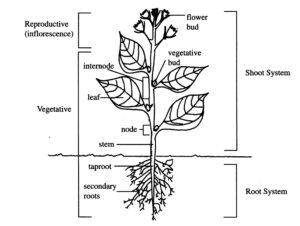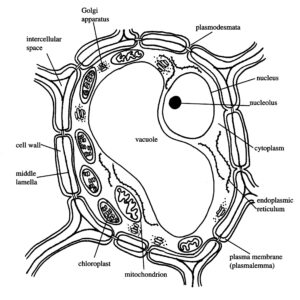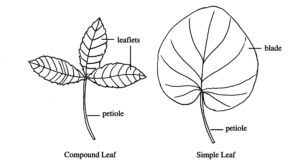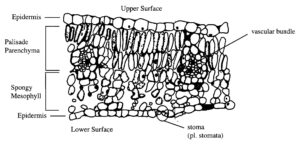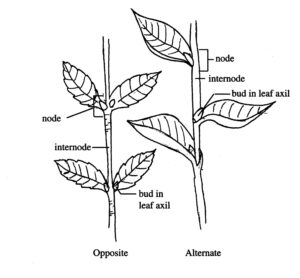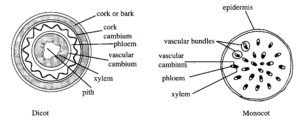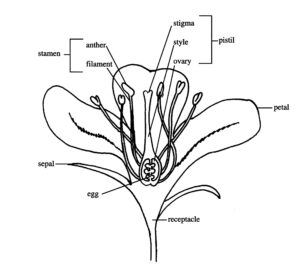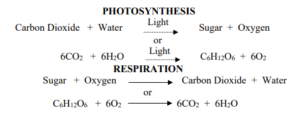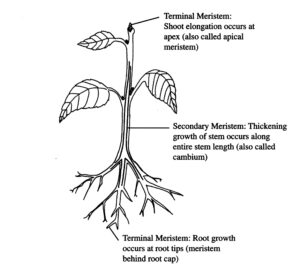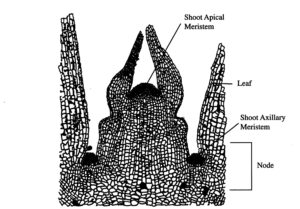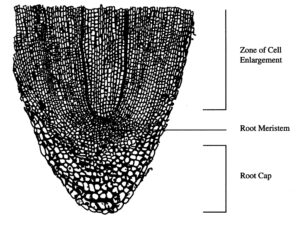Learning Objectives
From reading and studying this chapter, you should be able to:
- Recognize and use proper terminology in reference to the basic parts of a plant
- Understand the organization of a plant on a tissue and organ level
- Understand the basic physiological processes that go on in a plant
- Describe the various stages of development in a plant’s life cycle
- Understand the developmental control mechanisms in a plant
- Appreciate some plant responses to environmental conditions
Introductory Comments
The intent of this chapter is to provide you with a basic knowledge of plant form and an understanding of how plants work, both internally and in response to environment. It is essential, even for the most basic activities, that a horticulturist have a working knowledge of plant structure and the accompanying descriptive terminology. Then, once basic plant functions are understood and plant responses to environment are recognized, the effects of horticultural manipulations can be understood and predicted. Together, this knowledge provides a foundation for success in plant growing and management.
Plant Structure
Plants are composed of two major sub-units (Figure 1.) The part usually found above ground is the Shoot System. It may be composed of both “growing” (vegetative) parts and “flowering” (reproductive) parts. In addition to reproduction for survival of the species, the shoot system supplies food energy to the whole plant through the capture of light energy and gases from the atmosphere. It is, however, very much dependent on the other sub-unit (roots) for water and nutrients.
The second major sub-unit of a plant is the Root System. It is found below ground, generally, and is exclusively made up of “growing” or vegetative parts. The root system supplies water and nutrients to the whole plant, but is dependent upon the shoot system for food. The roots also must procure adequate oxygen from the soil for internal root respiration (see Growth and Developmental Processes, below.) Among the general public, the root system too often is forgotten, following the old adage, “out of sight, out of mind.” A horticulturist’s attitude should be “out of sight, but NEVER out of mind.” Why? Because balance between shoot and root systems is essential for plant health. For example, adverse environmental conditions that cause root decline such as waterlogged soil can also result in shoot dieback. Alternatively, severe pruning or a plant disease that causes leaf loss can diminish the vigor of a root system, although the effect usually goes unnoticed.
The Internal Plant Body
Plants are composed of cells, the basic building block of living organisms (Figure 2). Cells are microscopic. There are many different, “specialized” cells in a plant body, each with specific functions. It is inside the cells where the most basic “growth processes” occur.
Tissues are organized groups of large numbers of cells. Tissues are specialized in form to accomplish a particular function. Important tissues are the “skin” of the plant (epidermal tissues), the “growing & dividing” areas of cells (meristematic tissues) and the “plumbing” parts that allow material to move around in a plant (vessels or vascular tissues.)
Organs are composed of multiple tissues. They are complex, organized functional units. Important vegetative organs are: leaves, stems, buds, roots. Reproductive organs are the flowers, fruits and seeds.
Monocots versus Dicots: A Word About a Useful Way of Grouping Flowering Plants
Flowering plants are often divided into two groups, Monocotyledons and Dicotyledons (Table 1), with distinct, easily recognizable structural features. The groups are so named for the number of “seed leaves” (cotyledons) found in the seeds of the plants in each group. Although this grouping is now recognized as an evolutionary branch, but not a fundamental division of all plants, it can be useful. The differences between monocots and dicots can be important to plant management such as for predicting responses to herbicides or for understanding growth patterns in relation to pruning.
| Characteristic | Dicots | Monocots |
|---|---|---|
| Number of flower parts | Four or five, or multiples | Three, or multiples |
| Seed leaves (cotyledons) | Two | One |
| Leaf venation | Net-like | Parallel |
| Vascular system location in stems (cross section) | In a single ring (cambial meristem) | Many bundles dispersed throughout (intercalary) |
| True secondary growth of stems (increase in diameter of stem) | Common | Absent |
| Some examples | Most broadleaf trees and shrubs, many herbaceous annuals and perennials | Grasses, iris, lilies, orchids |
Vegetative Plant Body, Organs and Their Functions
Leaf
The leaf is the food factory of a plant. Its function is energy capture from sunlight via the process of photosynthesis (see below).
Structurally, the typical leaf is composed of a flat part (blade) and a stalk (petiole) (Figure 3). A simple leaf is one with a single blade and petiole while compound leaves have more than one of each part. Leaves are usually described by their overall shape, the leaf edge (margin), and the venation pattern (see Chapter 2 for diagrams.) Many variations of leaves occur, but some that are most visually interesting are those that are variegated, or have a color on part of the leaf that is different from the normal, usually green, color. For example, variegated leaves may have a crisp white edge, or there may be mottled blotches of white, yellow, maroon and green, etc. We refer to the leaves of most conifers as ‘needles’, but they are food factories nonetheless.
The internal structure of a typical leaf is like a peanut butter and jelly sandwich. The outer layers (bread slices) are epidermal tissue, while palisade parenchyma cells (thick peanut butter) and spongy mesophyll cells (jelly) make up the sandwich filling (Figure 4). These cells are the site of most photosynthesis. Holes occur in the epidermal layer of leaves. Called stomata, the holes can be opened and closed by the plant. This gives the plant control over movement of water vapor out of the leaf and movement of gases (carbon dioxide and oxygen) in or out of the leaf. Closing the stomata is the plant’s first line of defense against water loss when drought occurs.
Leaves are attached to a stem, usually by the petiole. The point of attachment is called a node.
Stem
There are two main functions of stems. One is as a support and distribution structure for leaves. Equally important is the stem’s role as a channel for movement of water and nutrients from soil into the plant, and for movement of manufactured food and other materials among the various plant tissues and organs.
In woody plants, stems comprise a main part of the perennial plant body. Commonly, stems are linear and erect above ground, but, many modifications of stems occur. Some grow horizontally along the ground or underground (stolons, rhizomes, tubers) and some are significantly compressed (rosette, crown). First-year stems (called shoots) bear leaves in a distinct pattern (opposite or alternate, see Figure 5.)
At each node (point of leaf attachment) there is a bud on the stem, located in the area called the leaf axil.
The vascular tissue in stems is composed of xylem and phloem. Xylem vessels allow for water and nutrient movement from roots to leaves. Phloem is the pathway for movement of many materials including the energy-storage products of photosynthesis around within the plant. There are two internal arrangements of vessels in stems (Figure 6.)
Either xylem and phloem bundles are dispersed (monocots) or the xylem, phloem and cambium cells form a continuous single ring around a central pith (dicots). The dicot arrangement allows for secondary growth. That is, stem growth in the form of annual increase in stem thickness (ie. a tree trunk that gets larger in diameter each year). Importantly, secondary growth and the single ring of vascular elements around the outer part of a dicot stem means constriction (ie. girdling by wire or twine left around a stem) or injury (ie. by a mower or weed trimmer) can cause plant death by disconnecting the root system from the shoot system.
Bud
A bud functions as the growing point or the location for the re-commencement of growth. It is a structure that contains immature plant parts. Around the growing point, a bud is often composed of protective layers of structures called scales which protect the developing organs inside from adverse environmental conditions such as dryness.
The primary types of buds are:
• Vegetative, containing an immature stem and leaves
• Floral, containing an immature flower(s)
• Both vegetative and floral parts in one
Buds normally occur in two locations (Figure 7):
• At the end of a shoot (stem) – called a terminal bud
• At a node in a leaf axil – called a lateral or axillary bud
Buds that form in locations other than the normal ones are called adventitious buds. “Water sprouts” that grow after pruning, or upright “suckers” at the base of crabapple trees often result from adventitious buds.
Root
The functions of a root include anchoring the plant to the soil, providing an entry point for uptake of water and minerals from soil, and providing a storage location for food reserves.
Roots are usually underground, but may occur partly above ground in some situations. The primary root is the first root to grow from a seed. Secondary, tertiary, etc. roots develop as branching from a primary root. Types of roots include:
• Tap root, a thick unbranched primary root, which usually, even on large trees, extends not more than a few feet into the ground (common in dicots)
• Fibrous roots, initially branch from a primary root forming a net-like mass (common in monocots and as secondary roots in dicots)
• Fleshy root, similar to a taproot, only branched
All roots share a common “fine structure” at the growing root tip (Figure 8.) Here, the root cap protects the end and cell meristem region. Behind the zone of cell division (meristem) is the main part of the root responsible for water and nutrient uptake. It is typically covered with fine root hairs that extend the “reach” of a root into the soil. Many plants form mycorrhizae, or root-fungus associations which increase even further the area of soil that can be explored by a root.
New roots normally form as branches from existing roots. They may, however, form on stems or even leaves. Called adventitious roots, these are important in plant propagation as they permit rooting of stem and/or leaf cuttings.
Reproductive Organs and Their Functions
Flower
The function of a flower is sexual reproduction and the subsequent development of seeds. It is often accompanied by the re-assortment of genes among individuals within a species. Flowers are usually the showiest part of a plant. They may be fragrant, too. Both these characteristics are useful to the plant to attract pollinators, but they are also, frequently, the reason the plant is grown as a landscape or garden ornamental.
Typical flower parts (Figure 9) and their functions are:
• Sepals, protect the developing flower, they may be showy or not, and ‘open’ just prior to the colorful petals
• Petals, attract pollinators, often showy
• Stamens (male), location of pollen development and distribution
• Pistil(s) (female), location of ovule development and organ in which fertilized ovules develop into seeds
Flowers can occur with all four parts present (complete) or with one or more of the parts missing (incomplete). They also occur with both sexual parts present (perfect) or one of the sexual parts missing (imperfect). Imperfect flowers (male-only flowers and female-only flowers) may occur on one plant (called monecious) or two separate plants (called dioecious). A few important ornamentals such as holly are dioecious. For holly plants to produce colorful berries in the landscape, female plants must be planted, but also, at least a few male plants must be planted to provide pollen for seed and fruit set. Flowers may be borne singly or in groups in various sorts of structures called inflorescences (see Chapter 2 for diagrams.)
Fruit
A fruit functions to protect the developing seeds and is a device to aid in seed dispersal. Many fruits have an attractiveness to animals which may eat the fruit, move some distance from the plant and later, expel the seeds. A fruit is, botanically, the mature ovary from a flower, and fruits occur in a wide variety of forms.
Fruits may be highly ornamental or may be a nuisance or problem. Crabapples and hawthorns produce attractive colorful fruits that only sometimes become a man-agement problem. Sweetgum trees produce spiny fruits which can be a nuisance under foot. The maidenhair tree (Ginkgo) is notorious for production, on female trees only, of fruits which produce a highly offensive odor when ripe. Chemical prevention of fruit set is a landscape management practice that may be desirable for such species. Of course, better plant selection can prevent the problem entirely.
Seed
The function of a seed is to provide for the next generation of the species. Seeds are a “resting” stage of plant development that allows a species to survive through periods of adverse environmental conditions. A seed is a structure that contains a small plant (embryo) and food for the embryo and is surrounded by a protective covering (seed coat).
Plant Growth and Development
Growth and Developmental Stages
Seed Germination
This is the stage in which the embryo in a seed begins to grow. It occurs due to both correct environmental conditions and appropriate physiological condition of the embryo.
A seed is said to be dormant when it will not grow, even given correct environmental conditions. Dormancy may be physical such as when a thick, hard seed coat prevents moisture entering the seed, or it may be physiological such as when a seed does not germinate due to the internal chemical status of the embryo itself.
Juvenility
This stage of development is defined by growth in a vegetative mode only, even if the plant is provided with favorable environmental conditions and stimuli to produce flowers. A juvenile plant is not able to produce flowers.
A plant in this growth stage may look different than one of the same species in the mature growth stage (see below). An example is English Ivy (Hedera) which grows as the familiar leafy, viney, creeping groundcover in the juvenile stage, but has an upright habit with altered leaf shape when mature. Severe pruning can often cause a return to juvenility by a plant that has been in a mature state.
Oak trees often retain dead leaves in winter in the lowest part of the canopy. This is a juvenile behavior. That lowest part of the canopy developed when the plant was in a juvenile stage and it retains that characteristic even after the tree becomes mature.
Maturity
In this stage a plant is able to produce flowers if provided with favorable environmental conditions and stimuli. Mature plants are not always “in flower,” but they are capable of flowering.
Senescence
In this stage, a plant organ goes through an organized preparatory process prior to death. It generally involves removal of nutrients from the plant organ that will die to those parts of the plant that will remain alive. Examples are a deciduous tree that loses its leaves in fall, or a herbaceous perennial that dies back to the ground in the fall, but stores food reserves in its root and crown.
Dormancy
This is a developmental stage in which growth slows or stops. It is a plant adaptation that allows for survival through periods of environmental stress. For example, in Indiana, woody plants become dormant in order to survive winter cold. Growth can re-start when the environment is once again favorable.
Growth and Developmental Processes
Photosynthesis
Photosynthesis is the process by which plants capture light energy for growth. It is a two step process that 1) captures the energy and 2) stores it. In so doing, photosynthesis combines water and carbon dioxide to form sugar and releases oxygen (Figure 10.) The captured energy is stored in the connections (chemical bonds) between atoms in the sugar.
Respiration
Respiration is the process through which stored energy is released to do the work of growing. It is
essentially the reverse of photosynthesis and it uses oxygen while producing water and carbon dioxide (Figure 10.)
Transpiration
Transpiration is the movement of water through a plant from soil to air. The vessel in which transpiration occurs is the xylem. It involves water moving from the soil into the root then ultimately evaporation moves the water from the leaf to the atmosphere. The evaporative process, in effect “pulls” w ater from soil and up through the plant. In addition to the cooling effect of evaporation, the “transpiration stream” provides transport for nutrients from soil into all parts of the plant.
Translocation
Translocation is the movement of materials around in a plant. The vessel in which translocation occurs is the phloem. It includes food moving from where it is produced to where it is used as well as the movement of chemical signals from one part of the plant to another.
Metabolism
Metabolism is a term that refers to the activity within cells that includes all the chemistry of life. Nutrients from the soil and the sugars produced in photosynthesis are the basic raw materials. The energy captured in photosynthesis provides the power or force driving these metabolic, or growth, activities.
Cell division and expansion
Cell division and expansion as the basis of plant growth (increase in size of the organism) takes place in a region of tissue called a meristem. The only function of meristematic cells is to multiply themselves. In this way, new cells are produced that can become the new tissues and organs of the growing plant. Most cells, soon after they are produced in a meristem, become specialized. The actual cells of the meristem, however, never change, but retain the ability to multiply themselves.
There are just a few main types of meristems (Figure 11.) Primary shoot extension growth results from activity in a terminal meristem, also referred to as the apical meristem (Figure 11). Lateral branch growth comes about from a meristem at the node in a leaf axil, or an axillary meristem (Figure 12). An intact terminal (apical) meristem actually inhibits development of the axillary meristem during a growing season, and this phenomenon is know as apical dominance. It is because of apical dominance that plants increase in size. More details about apical dominance are below (see Auxins), and are discussed in IAH Chapter 6. Installing and Maintaining Landscape Plants in the Pruning section.
A terminal (root tip) meristem is also responsible for root extension growth (Figure 13). The cambium, a meristem between the xylem and phloem just under the outer surface of a woody dicot stem, is responsible for secondary growth of tree and shrub stems and trunks. Its location makes it easy to understand why mower blight (‘weed-eater disease’) or the activity of boring insects just under the bark of a tree can be so damaging to plant health.
A lesser known type of meristem is intercalary. Literally, this is a meristem found between tissues. An important example in the landscape is the intercalary meristem found at the base of blades of grass. If a grass blade had a terminal meristem, one mowing would cut it off and the grass would grow no more. But an intercalary meristem at the base of a grass blade allows for the tip to be removed yet the grass blade can continue to elongate.
Control of Growth by Hormones
A plant hormone is a substance produced in one part of a plant and translocated to another part of a plant. Then, at a very low concentration, it influences growth and developmental processes at that target location.
Auxins
Auxins promote cell division & elongation, but depending on concentration, can also inhibit the same activities. The phenomenon of apical dominance, that is the ability of a shoot terminal meristem to suppress growth of axillary or lateral buds behind the shoot tip involves auxin as the controlling substance.
Manipulation of apical dominance (auxin level) by the removal of a shoot tip to promote lateral branching is important in shrub pruning. Auxins are also involved in plant responses to gravity (providing the typical plant orientation to grow up), and to light (plant orientation to grow toward higher light intensity).
Gibberellins
Gibberellins promote internode (the region of the stem between nodes) elongation. They also help control flowering in some species.
Cytokinins
Cytokinins primarily control and promote cell division and tend to work against auxins in apical dominance. In general this hormone acts to promote growth and “youthfulness” in a plant as a counter to aging processes.
Abscisic Acid
Abscisic Acid causes growth cessation, or dormancy in seeds and buds. It is also involved in the separation of plant parts from the main plant body (abscission) such as in the case of autumn leaf drop in deciduous woody plants. A plant’s response to environmental stress often involves abscisic acid. In general, it can be thought of as the “brake pedal” on plant growth and development.
Ethylene
Ethylene is the only plant hormone that is a gas. It promotes tissue aging, such as the ripening of fruit.
Control of Growth by Growth Regulators
A plant growth regulator, (often referred to as PGR’s) is a synthetic substance that acts like one of the naturally occurring hormones or may act counter to a hormonal effect. Growth regulators are generally applied to plants externally. Commercial products such as B-9 or cycocel are used as growth retardants, reducing internode elongation with an anti-gibberellin effect. Auxin-like compounds such as IBA are used to promote root development on cuttings in nursery propagation. Some compounds that have growth regulator activity can also be used as potent herbicides. The most familiar example of this is 2,4-D found in many broadleaf herbicides for lawns.
Environmental Factors Influencing Plant Growth
Light
The key characteristics of light that are important to plants are: quality (wave length which humans see as color), quantity (intensity or how bright), and photoperiod (daily duration of light versus dark). Light influences many plant processes such as plant growth rate, flowering, stem elongation and the onset of d d dormancy.
Plants range in adaptation from tolerating a wide range of light intensities (i.e. many viburnum shrubs will grow in conditions from full sun to deep shade) to a very narrow tolerance (i.e. a paper birch tree will slowly decline and fail if planted in conditions of less than full sun). Successful landscape planters pay close attention to correct light conditions when placing plants.
Common guidelines suggest full sun means direct sunlight for at least 6 or 7 hours per day and shade means no more than 2 hours of direct sunlight per day. A caution is in order, however. Definitions of terms such as partial sun, partial shade, and deep shade are non-specific and thus only somewhat useful. For example partial shade might mean direct sun part of the day and complete shade the other part. Or it might mean very bright, filtered shade conditions all day. To be totally certain of a particular plant’s tolerance to specific light conditions, it must be grown under those conditions. Thus, experience is very valuable.
Light conditions typically change in developed landscapes in 10 – 20 years. This often necessitates changes to the planting design and plant selections.
Temperature
Extreme low winter temperatures are a key determinant limiting what landscape plants can be grown in a particular place. A plant’s ability to tolerate cold temperatures is called its cold hardiness and is usually described in terms of temperature degrees (°F or °C). The U.S.D.A. Hardiness Zone Map is useful as a guide to the required hardiness for any given part of the U.S. (https://planthardiness.ars.usda.gov/). Some woody plant shoot systems may not be hardy in a given location, but their root system may survive due to the protection of soil. These plants may be treated as herbaceous plants in a cold region and a woody plant in a warmer one. An example of this is butterflybush (Buddleia) which often dies to the ground in Indiana, but is a woody shrub further south.
Annual cool temperatures are required by many temperate plants for normal growth. Hardy bulbs such as tulips and daffodils must experience cool conditions to flower normally. A plant also requires a minimum amount of warm temperatures, or “growing season” for a complete life cycle. A few long-season plants may survive in a location and grow vegetatively with success, but “run out” of season to flower and produce fruit.
Water
Water is basic to the existence of all life, plant or animal. In herbaceous plants, water is often the largest single component of the plant. A plant will only survive where water availability for uptake, both in quantity and timing of availability, meets its requirements. In horticultural management, irrigation is often used to more nearly optimize water availability.
Excess water in the environment, especially the root zone, can indirectly cause problems for plants by excluding oxygen and providing a favorable habitat for harmful micro-organisms. A root zone with adequate water-holding capacity and positive drainage is generally ideal.
Nutrients
Many elements are essential to plant growth (see Chapter 5, Soils & Plant Nutrition.) Most are taken up via the root system. Any nutrient may be available in a plant’s root zone in a less than optimum amount which will limit that plant’s ability to grow. This is one aspect of a landscape plant’s environment which is frequently altered through the management activity of fertilization.
Gases
The gases oxygen and carbon dioxide are required for plant health. In a landscape or nursery context, there is essentially nothing that can be done to alter the naturally occurring gas levels in the atmosphere. In the enclosed conditions of greenhouse production, extra carbon dioxide is sometimes added to the air to promote faster growth.
Gas levels in the soil, especially oxygen required by roots for respiration, can be promoted. The simplest approach is to provide a well-structured growing medium with abundant room for air between soil particles. While soil air generally has less oxygen and more carbon dioxide than the air in the atmosphere, the rate of movement of air into and out of the soil (gas exchange) is key. Large spaces and uncompacted soil allow for the most rapid gas exchange between the soil air and the above-ground atmosphere resulting in the highest possible soil oxygen level (See Chapter 5, Soils & Plant Nutrition.)
Gaseous pollutants can negatively impact landscape plant growth. Various atmospheric pollutants can damage leaves and impair their function. Even plant roots can be harmed by gaseous pollution. Gas leaks from natural gas supply lines, or methane leaks from landfills have been known to kill plant roots.
Vegetative Plant Body, Organs and Their Functions
Leaf
The leaf is the food factory of a plant. Its function is energy capture from sunlight via the process of photosynthesis (see below).
Structurally, the typical leaf is composed of a flat part (blade) and a stalk (petiole) (Figure 3). A simple leaf is one with a single blade and petiole while compound leaves have more than one of each part. Leaves are usually described by their overall shape, the leaf edge (margin), and the venation pattern (see Chapter 2 for diagrams.) Many variations of leaves occur, but some that are most visually interesting are those that are variegated, or have a color on part of the leaf that is different from the normal, usually green, color. For example, variegated leaves may have a crisp white edge, or there may be mottled blotches of white, yellow, maroon and green, etc. We refer to the leaves of most conifers as ‘needles’, but they are food factories nonetheless.
The internal structure of a typical leaf is like a peanut butter and jelly sandwich. The outer layers (bread slices) are epidermal tissue, while palisade parenchyma cells (thick peanut butter) and spongy mesophyll cells (jelly) make up the sandwich filling (Figure 4). These cells are the site of most photosynthesis. Holes occur in the epidermal layer of leaves. Called stomata, the holes can be opened and closed by the plant. This gives the plant control over movement of water vapor out of the leaf and movement of gases (carbon dioxide and oxygen) in or out of the leaf. Closing the stomata is the plant’s first line of defense against water loss when drought occurs.
Leaves are attached to a stem, usually by the petiole. The point of attachment is called a node.
Stem
There are two main functions of stems. One is as a support and distribution structure for leaves. Equally important is the stem’s role as a channel for movement of water and nutrients from soil into the plant, and for movement of manufactured food and other materials among the various plant tissues and organs.
In woody plants, stems comprise a main part of the perennial plant body. Commonly, stems are linear and erect above ground, but, many modifications of stems occur. Some grow horizontally along the ground or underground (stolons, rhizomes, tubers) and some are significantly compressed (rosette, crown). First-year stems (called shoots) bear leaves in a distinct pattern (opposite or alternate, see Figure 5.)
At each node (point of leaf attachment) there is a bud on the stem, located in the area called the leaf axil.
The vascular tissue in stems is composed of xylem and phloem. Xylem vessels allow for water and nutrient movement from roots to leaves. Phloem is the pathway for movement of many materials including the energy-storage products of photosynthesis around within the plant. There are two internal arrangements of vessels in stems (Figure 6.)
Either xylem and phloem bundles are dispersed (monocots) or the xylem, phloem and cambium cells form a continuous single ring around a central pith (dicots). The dicot arrangement allows for secondary growth. That is, stem growth in the form of annual increase in stem thickness (ie. a tree trunk that gets larger in diameter each year). Importantly, secondary growth and the single ring of vascular elements around the outer part of a dicot stem means constriction (ie. girdling by wire or twine left around a stem) or injury (ie. by a mower or weed trimmer) can cause plant death by disconnecting the root system from the shoot system.
Bud
A bud functions as the growing point or the location for the re-commencement of growth. It is a structure that contains immature plant parts. Around the growing point, a bud is often composed of protective layers of structures called scales which protect the developing organs inside from adverse environmental conditions such as dryness.
The primary types of buds are:
• Vegetative, containing an immature stem and leaves
• Floral, containing an immature flower(s)
• Both vegetative and floral parts in one
Buds normally occur in two locations (Figure 7):
• At the end of a shoot (stem) – called a terminal bud
• At a node in a leaf axil – called a lateral or axillary bud
Buds that form in locations other than the normal ones are called adventitious buds. “Water sprouts” that grow after pruning, or upright “suckers” at the base of crabapple trees often result from adventitious buds.
Root
The functions of a root include anchoring the plant to the soil, providing an entry point for uptake of water and minerals from soil, and providing a storage location for food reserves.
Roots are usually underground, but may occur partly above ground in some situations. The primary root is the first root to grow from a seed. Secondary, tertiary, etc. roots develop as branching from a primary root. Types of roots include:
• Tap root, a thick unbranched primary root, which usually, even on large trees, extends not more than a few feet into the ground (common in dicots)
• Fibrous roots, initially branch from a primary root forming a net-like mass (common in monocots and as secondary roots in dicots)
• Fleshy root, similar to a taproot, only branched
All roots share a common “fine structure” at the growing root tip (Figure 8.) Here, the root cap protects the end and cell meristem region. Behind the zone of cell division (meristem) is the main part of the root responsible for water and nutrient uptake. It is typically covered with fine root hairs that extend the “reach” of a root into the soil. Many plants form mycorrhizae, or root-fungus associations which increase even further the area of soil that can be explored by a root.
New roots normally form as branches from existing roots. They may, however, form on stems or even leaves. Called adventitious roots, these are important in plant propagation as they permit rooting of stem and/or leaf cuttings.
Reproductive Organs and Their Functions
Flower
The function of a flower is sexual reproduction and the subsequent development of seeds. It is often accompanied by the re-assortment of genes among individuals within a species. Flowers are usually the showiest part of a plant. They may be fragrant, too. Both these characteristics are useful to the plant to attract pollinators, but they are also, frequently, the reason the plant is grown as a landscape or garden ornamental.
Typical flower parts (Figure 9) and their functions are:
• Sepals, protect the developing flower, they may be showy or not, and ‘open’ just prior to the colorful petals
• Petals, attract pollinators, often showy
• Stamens (male), location of pollen development and distribution
• Pistil(s) (female), location of ovule development and organ in which fertilized ovules develop into seeds
Flowers can occur with all four parts present (complete) or with one or more of the parts missing (incomplete). They also occur with both sexual parts present (perfect) or one of the sexual parts missing (imperfect). Imperfect flowers (male-only flowers and female-only flowers) may occur on one plant (called monecious) or two separate plants (called dioecious). A few important ornamentals such as holly are dioecious. For holly plants to produce colorful berries in the landscape, female plants must be planted, but also, at least a few male plants must be planted to provide pollen for seed and fruit set. Flowers may be borne singly or in groups in various sorts of structures called inflorescences (see Chapter 2 for diagrams.)
Fruit
A fruit functions to protect the developing seeds and is a device to aid in seed dispersal. Many fruits have an attractiveness to animals which may eat the fruit, move some distance from the plant and later, expel the seeds. A fruit is, botanically, the mature ovary from a flower, and fruits occur in a wide variety of forms.
Fruits may be highly ornamental or may be a nuisance or problem. Crabapples and hawthorns produce attractive colorful fruits that only sometimes become a man-agement problem. Sweetgum trees produce spiny fruits which can be a nuisance under foot. The maidenhair tree (Ginkgo) is notorious for production, on female trees only, of fruits which produce a highly offensive odor when ripe. Chemical prevention of fruit set is a landscape management practice that may be desirable for such species. Of course, better plant selection can prevent the problem entirely.
Seed
The function of a seed is to provide for the next generation of the species. Seeds are a “resting” stage of plant development that allows a species to survive through periods of adverse environmental conditions. A seed is a structure that contains a small plant (embryo) and food for the embryo and is surrounded by a protective covering (seed coat).
Plant Growth and Development
Growth and Developmental Stages
Seed Germination
This is the stage in which the embryo in a seed begins to grow. It occurs due to both correct environmental conditions and appropriate physiological condition of the embryo.
A seed is said to be dormant when it will not grow, even given correct environmental conditions. Dormancy may be physical such as when a thick, hard seed coat prevents moisture entering the seed, or it may be physiological such as when a seed does not germinate due to the internal chemical status of the embryo itself.
Juvenility
This stage of development is defined by growth in a vegetative mode only, even if the plant is provided with favorable environmental conditions and stimuli to produce flowers. A juvenile plant is not able to produce flowers.
A plant in this growth stage may look different than one of the same species in the mature growth stage (see below). An example is English Ivy (Hedera) which grows as the familiar leafy, viney, creeping groundcover in the juvenile stage, but has an upright habit with altered leaf shape when mature. Severe pruning can often cause a return to juvenility by a plant that has been in a mature state.
Oak trees often retain dead leaves in winter in the lowest part of the canopy. This is a juvenile behavior. That lowest part of the canopy developed when the plant was in a juvenile stage and it retains that characteristic even after the tree becomes mature.
Maturity
In this stage a plant is able to produce flowers if provided with favorable environmental conditions and stimuli. Mature plants are not always “in flower,” but they are capable of flowering.
Senescence
In this stage, a plant organ goes through an organized preparatory process prior to death. It generally involves removal of nutrients from the plant organ that will die to those parts of the plant that will remain alive. Examples are a deciduous tree that loses its leaves in fall, or a herbaceous perennial that dies back to the ground in the fall, but stores food reserves in its root and crown.
Dormancy
This is a developmental stage in which growth slows or stops. It is a plant adaptation that allows for survival through periods of environmental stress. For example, in Indiana, woody plants become dormant in order to survive winter cold. Growth can re-start when the environment is once again favorable.
Growth and Developmental Processes
Photosynthesis
Photosynthesis is the process by which plants capture light energy for growth. It is a two step process that 1) captures the energy and 2) stores it. In so doing, photosynthesis combines water and carbon dioxide to form sugar and releases oxygen (Figure 10.) The captured energy is stored in the connections (chemical bonds) between atoms in the sugar.
Respiration
Respiration is the process through which stored energy is released to do the work of growing. It is
essentially the reverse of photosynthesis and it uses oxygen while producing water and carbon dioxide (Figure 10.)
Transpiration
Transpiration is the movement of water through a plant from soil to air. The vessel in which transpiration occurs is the xylem. It involves water moving from the soil into the root then ultimately evaporation moves the water from the leaf to the atmosphere. The evaporative process, in effect “pulls” w ater from soil and up through the plant. In addition to the cooling effect of evaporation, the “transpiration stream” provides transport for nutrients from soil into all parts of the plant.
Translocation
Translocation is the movement of materials around in a plant. The vessel in which translocation occurs is the phloem. It includes food moving from where it is produced to where it is used as well as the movement of chemical signals from one part of the plant to another.
Metabolism
Metabolism is a term that refers to the activity within cells that includes all the chemistry of life. Nutrients from the soil and the sugars produced in photosynthesis are the basic raw materials. The energy captured in photosynthesis provides the power or force driving these metabolic, or growth, activities.
Cell division and expansion
Cell division and expansion as the basis of plant growth (increase in size of the organism) takes place in a region of tissue called a meristem. The only function of meristematic cells is to multiply themselves. In this way, new cells are produced that can become the new tissues and organs of the growing plant. Most cells, soon after they are produced in a meristem, become specialized. The actual cells of the meristem, however, never change, but retain the ability to multiply themselves.
There are just a few main types of meristems (Figure 11.) Primary shoot extension growth results from activity in a terminal meristem, also referred to as the apical meristem (Figure 11). Lateral branch growth comes about from a meristem at the node in a leaf axil, or an axillary meristem (Figure 12). An intact terminal (apical) meristem actually inhibits development of the axillary meristem during a growing season, and this phenomenon is know as apical dominance. It is because of apical dominance that plants increase in size. More details about apical dominance are below (see Auxins), and are discussed in IAH Chapter 6. Installing and Maintaining Landscape Plants in the Pruning section.
A terminal (root tip) meristem is also responsible for root extension growth (Figure 13). The cambium, a meristem between the xylem and phloem just under the outer surface of a woody dicot stem, is responsible for secondary growth of tree and shrub stems and trunks. Its location makes it easy to understand why mower blight (‘weed-eater disease’) or the activity of boring insects just under the bark of a tree can be so damaging to plant health.
A lesser known type of meristem is intercalary. Literally, this is a meristem found between tissues. An important example in the landscape is the intercalary meristem found at the base of blades of grass. If a grass blade had a terminal meristem, one mowing would cut it off and the grass would grow no more. But an intercalary meristem at the base of a grass blade allows for the tip to be removed yet the grass blade can continue to elongate.
Control of Growth by Hormones
A plant hormone is a substance produced in one part of a plant and translocated to another part of a plant. Then, at a very low concentration, it influences growth and developmental processes at that target location.
Auxins
Auxins promote cell division & elongation, but depending on concentration, can also inhibit the same activities. The phenomenon of apical dominance, that is the ability of a shoot terminal meristem to suppress growth of axillary or lateral buds behind the shoot tip involves auxin as the controlling substance.
Manipulation of apical dominance (auxin level) by the removal of a shoot tip to promote lateral branching is important in shrub pruning. Auxins are also involved in plant responses to gravity (providing the typical plant orientation to grow up), and to light (plant orientation to grow toward higher light intensity).
Gibberellins
Gibberellins promote internode (the region of the stem between nodes) elongation. They also help control flowering in some species.
Cytokinins
Cytokinins primarily control and promote cell division and tend to work against auxins in apical dominance. In general this hormone acts to promote growth and “youthfulness” in a plant as a counter to aging processes.
Abscisic Acid
Abscisic Acid causes growth cessation, or dormancy in seeds and buds. It is also involved in the separation of plant parts from the main plant body (abscission) such as in the case of autumn leaf drop in deciduous woody plants. A plant’s response to environmental stress often involves abscisic acid. In general, it can be thought of as the “brake pedal” on plant growth and development.
Ethylene
Ethylene is the only plant hormone that is a gas. It promotes tissue aging, such as the ripening of fruit.
Control of Growth by Growth Regulators
A plant growth regulator is a synthetic substance that acts like one of the naturally occurring hormones or may act counter to a hormonal effect. Growth regulators are generally applied to plants externally. Commercial products such as B-9 or cycocel are used as growth retardants, reducing internode elongation with an anti-gibberellin effect. Auxin-like compounds such as IBA are used to promote root development on cuttings in nursery propagation. Some compounds that have growth regulator activity can also be used as potent herbicides. The most familiar example of this is 2,4-D found in many broadleaf herbicides for lawns.
Environmental Factors Influencing Plant Growth
Light
The key characteristics of light that are important to plants are: quality (wave length which humans see as color), quantity (intensity or how bright), and photoperiod (daily duration of light versus dark). Light influences many plant processes such as plant growth rate, flowering, stem elongation and the onset of dormancy.
Plants range in adaptation from tolerating a wide range of light intensities (i.e. many viburnum shrubs will grow in conditions from full sun to deep shade) to a very narrow tolerance (i.e. a paper birch tree will slowly decline and fail if planted in conditions of less than full sun). Successful landscape planters pay close attention to correct light conditions when placing plants.
Common guidelines suggest full sun means direct sunlight for at least 6 or 7 hours per day and shade means no more than 2 hours of direct sunlight per day. A caution is in order, however. Definitions of terms such as partial sun, partial shade, and deep shade are non-specific and thus only somewhat useful. For example partial shade might mean direct sun part of the day and complete shade the other part. Or it might mean very bright, filtered shade conditions all day. To be totally certain of a particular plant’s tolerance to specific light conditions, it must be grown under those conditions. Thus, experience is very valuable.
Light conditions typically change in developed landscapes in 10 – 20 years. This often necessitates changes to the planting design and plant selections.
Temperature
Extreme low winter temperatures are a key determinant limiting what landscape plants can be grown in a particular place. A plant’s ability to tolerate cold temperatures is called its cold hardiness and is usually described in terms of temperature degrees (°F or °C). The U.S.D.A. Hardiness Zone Map is useful as a guide to the required hardiness for any given part of the U.S. (https://planthardiness.ars.usda.gov/). Some woody plant shoot systems may not be hardy in a given location, but their root system may survive due to the protection of soil. These plants may be treated as herbaceous plants in a cold region and a woody plant in a warmer one. An example of this is butterflybush (Buddleia) which often dies to the ground in Indiana, but is a woody shrub further south.
Annual cool temperatures are required by many temperate plants for normal growth. Hardy bulbs such as tulips and daffodils must experience cool conditions to flower normally. A plant also requires a minimum amount of warm temperatures, or “growing season” for a complete life cycle. A few long-season plants may survive in a location and grow vegetatively with success, but “run out” of season to flower and produce fruit.
Water
Water is basic to the existence of all life, plant or animal. In herbaceous plants, water is often the largest single component of the plant. A plant will only survive where water availability for uptake, both in quantity and timing of availability, meets its requirements. In horticultural management, irrigation is often used to more nearly optimize water availability.
Excess water in the environment, especially the root zone, can indirectly cause problems for plants by excluding oxygen and providing a favorable habitat for harmful micro-organisms. A root zone with adequate water-holding capacity and positive drainage is generally ideal.
Nutrients
Many elements are essential to plant growth (see Chapter 5, Soils & Plant Nutrition.) Most are taken up via the root system. Any nutrient may be available in a plant’s root zone in a less than optimum amount which will limit that plant’s ability to grow. This is one aspect of a landscape plant’s environment which is frequently altered through the management activity of fertilization.
Gases
The gases oxygen and carbon dioxide are required for plant health. In a landscape or nursery context, there is essentially nothing that can be done to alter the naturally occurring gas levels in the atmosphere. In the enclosed conditions of greenhouse production, extra carbon dioxide is sometimes added to the air to promote faster growth.
Gas levels in the soil, especially oxygen required by roots for respiration, can be promoted. The simplest approach is to provide a well-structured growing medium with abundant room for air between soil particles. While soil air generally has less oxygen and more carbon dioxide than the air in the atmosphere, the rate of movement of air into and out of the soil (gas exchange) is key. Large spaces and uncompacted soil allow for the most rapid gas exchange between the soil air and the above-ground atmosphere resulting in the highest possible soil oxygen level (See Chapter 5, Soils & Plant Nutrition.)
Gaseous pollutants can negatively impact landscape plant growth. Various atmospheric pollutants can damage leaves and impair their function. Even plant roots can be harmed by gaseous pollution. Gas leaks from natural gas supply lines, or methane leaks from landfills have been known to kill plant roots.
- True or False: The two basic sub-parts of a typical plant are the shoot system and the root system.
- Which one of the following is NOT a major plant tissue?
- Meristematic
- Transitory
- Vascular
- Epidermal
- True or False: Plants with leaf veins that run parallel to one another, like grasses, are examples of dicotyledonous plants.
- The point of attachment of a leaf, or leaves, to a stem is called a:
- junction
- crown
- union
- node
- True or False: The main function of a plant leaf is energy capture from sunlight via photosynthesis.
- True or False: Secondary growth of a woody dicot stem means such a plant is vulnerable to damage by weed trimmers or girdling wire that can disconnect the shoot system from the root system.
- True or False: A flowering plant that is not able to produce flowers, even when provided with optimum environmental conditions, is in a growth phase called juvenility.
- The basis of plant growth (size increase) is:
- Translocation
- Metabolism
- Cell Division & Expansion
- Transpiration
- Which of the following is not a plant hormone?
- Auxin
- Niacin
- Gibberellin
- Abscisic Acid
- Of the five categories of plant growth environmental factors, which one is typically not manipulated by horticulturists?
- Light
- Temperature
- Water
- Nutrients
- Gases
- True
- B
- False
- D
- True
- True
- True
- C
- B
- E
